Matador Network's Blog, page 1131
March 29, 2019
Where to eat at the Shanghai airport
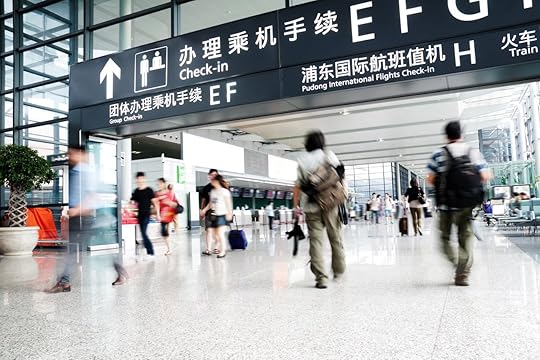
If you’re at all familiar with Shanghai’s great food scene, prepare to be disappointed. Despite being one of the world’s most-traveled-through airports, Shanghai Pudong International Airport is woefully sparse of good restaurants or bars to kill time while waiting for a flight. The lack of options has inspired locals and tourists alike to claim they don’t eat at the airport except when “in [a] starving situation,” and that the “best bet is Burger King or Subway.” Though after a long, grueling flight if you’re coming from the States, the Starbucks can be a welcome sight.
If you don’t want American fast food, these are your best options for both terminals. You’ll be eating before going through security here, so make sure to give yourself enough time (all of the options are on the quicker side, though). Other than the below, you’re generally stuck with quick tea and coffee shops.
Terminal 1
Tai Hing: A fast sit down restaurant that focuses on Cantonese dishes. There are soup, noodle, and rice dishes, along with pork, duck, and shrimp. Don’t expect anything fancy (food comes on a plastic tray), but it will fill you up.
Tsui Wah: Clean and easy Hong Kong-style fast food. Wonton noodles, fish balls, and other Cantonese classics fill the menu, and those not hungry can stick with some green tea.
Chez Choux: While admittedly not a restaurant, Chez Choux is a fine stop for a wide variety of choux pastries. Choux is a fluffy pastry that uses steam to puff up rather than yeast or baking soda.
Sunrise Restaurant: A mix of Western and Chinese food. You can choose noodle soups or dumplings or burger and fries. If you’re really feeling out there, there’s pizza.
Yu Ren Wan: One of the only halal restaurants, offering noodle dishes, tea, and juices.
Terminal 2
Tian Xia Dumplings: Maybe you’re sick of dumplings, but Terminal 2 is a land primarily populated by Hope Star Coffee Shops and Western fast food, so there’s not much else.
Grappa’s Cellar: An Italian-themed restaurant bar with bright red Mediterranean colors and Italian coffee, European beer, and simple cocktails.
Ajisen Ramen: An always trustworthy chain of Japanese noodle shops that has locations around the world.
Yonghe King: The outpost of a large chain with restaurants throughout Taiwan and mainland China. Breakfast options include youtiao (kind of like a Chinese doughnut) and rice and noodle dishes with pork, chicken, and beef. 

More like this: 6 regional Chinese dishes that show off the country’s culinary diversity
The post Where to eat and drink in Shanghai Pudong International Airport appeared first on Matador Network.

The best-looking bars in Italy

With centuries of iconic design to draw on, Italy is home to many expertly styled drinking establishments. In Milan, you can enter a bar and be transported back in time to Italy’s rationalism of the ‘30s or the iconic industrial look of the ‘50s. Further south, convention goes out the window with a flamingo-filled tropical bar in Puglia and a smoky speakeasy in Rome. A trip to Italy is filled with beautiful architecture and design, which goes just as much for the bars as it does the fashion and historical landmarks. Make sure these well-designed bars are on your next Italy travel itinerary, both for the drinks and the atmosphere.
1. Ceresio 7 in Milan
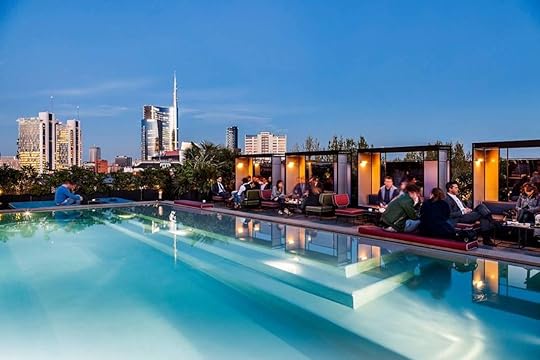
Photo: Ceresio 7 Pools & Restaurant/Facebook
Ceresio 7 is a rooftop bar and restaurant located on top of a historic rationalist building in Milan built in the Fascist era. The interior design takes after the exterior with a rationalist ‘30s aesthetic characterized by clean, geometric shapes. There are rectangular, brass-topped booths, floor-to-ceiling windows, red lacquered tables, plush teal chairs, and suspended strip lighting. This bar menu features classic American cocktails with a “strongly Italian twist and identity” and house-made bitters.
Ceresio 7 aims wholeheartedly at the luxury market with a terrace and swimming pool that overlooks the Milan skyline. Here, too, the vintage look is continued with angular turquoise leather sun loungers, grey stone floor slabs, and individual booths with Mondrian-style rectangular panels.
Where: Via Ceresio, 7, 20154 Milano MI, Italy
2. Bar Luce in Milan
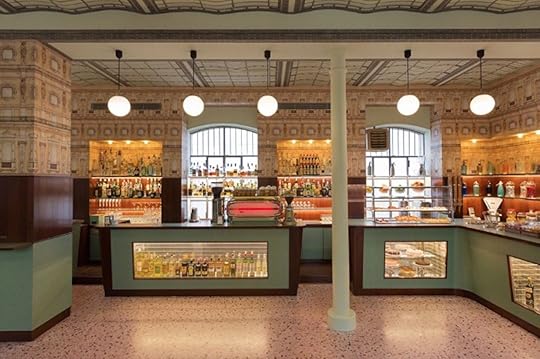
Photo: Fondazione Prada
Located in the cultural complex of the Fondazione Prada, this idiosyncratic bar was designed by Wes Anderson. Bar Luce bears all the hallmarks of his retro style, with Formica furniture, an industrial-style bar, and veneered wooden panels. The subdued turquoise and beige color palette is typical Wes Anderson but also harkens back to the aesthetics of 1950s Italy. Anderson’s design kept specific elements of the original structure of the building, such as the arched glass roof that’s a scaled-down replica of the ceiling of Milan’s famous shopping arcade, Galleria Vittorio Emanuele. Anderson described the interior as just like one of his film sets and as “a bar I would want to spend my own non-fictional afternoons in.” This is the place for a classic Italian drink like a Campari soda.
Where: Largo Isarco, 2, 20139 Milano MI, Italy
3. Caffé Propaganda in Rome
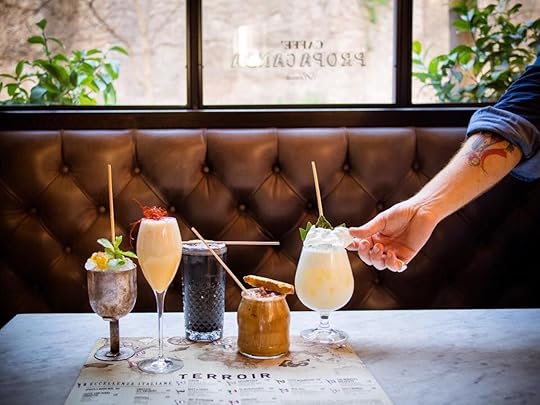
Photo: Caffè Propaganda/Facebook
Caffé Propaganda’s style and inspiration is eclectic. White, subway-style ceramic tiles cover the walls, and light comes from big factory windows. Rustic French bistro decorations like pots and pans hang as decoration, enormous chandeliers hang from the high ceilings, and Bauhaus-inspired stools are at the bar. The airy space and black and white floor make it temptingly fresh in summer, and it’s conveniently located a short walk from the Colosseum. The treats menu offers plays on classics like tiramisù and macaroons, and the cocktail menu is designed by in-house mixologist Patrick Pistolesi.
Where: Via Claudia, 15, 00184 Roma RM, Italy
4. Bit — Bloom in Town in Molfetta
View this post on Instagram
Flat Earth Cruise will sail
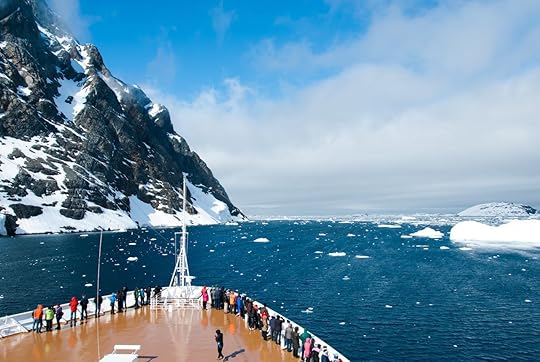
As mind-boggling as it sounds, there are people out there who think the earth is flat. They are convinced that the planet is not a globe, but a disk, with an edge that is an ice wall. This ice wall is supposed to be Antarctica and what lies beyond it is apparently a great mystery that flat-earthers cannot wait to decipher.
To prove this theory, the Flat Earth International Conference is organizing a Flat Earth Cruise to the “edge of the world,” i.e. the seventh continent, in 2020. Very few details have been released about the voyage as of yet, but FEIC promotes the event as the “biggest, boldest, best adventure yet.”
“Beyond the ice wall is a topic of great interest to the Flat Earth Society,” it says on its website. “To our knowledge, no one has been very far past the ice wall and returned to tell the journey.”
While it’s certainly an appealing sales pitch for deluded adventurers, we’re hoping the trip will be eye-opening — but there’s no telling with flat-earthers.
More details about this cruise will likely be revealed at the Flat Earth International Conference in November, in Dallas. But if looking for the nonexistent “edge of the earth” isn’t really your thing, or if you’ve actually listened in school, there are plenty of non-conspiracy based, cool cruises out there, including to Antarctica. 
H/T: Lonely Planet

More like this: 7 actually cool cruises that are nothing like the ones your parents take
The post A Flat Earth Cruise will sail to the ‘edge of the world’ in 2020 appeared first on Matador Network.

March 28, 2019
Traveling solo in your 20s

In my first year post-graduation, I had time, potential, and no clue what to do with myself. The options were endless, and the only thing I knew was that I wanted to travel. The early 20s were a confusing time of life for me, and at the time I had a much better idea of the things I didn’t want to do than what I did. While millennials are #blessed to have more readily available options for personal growth and career development than prior generations, the sheer number of choices can be overwhelming. This was my quarter-life crisis, and the only thing I could think of to solve this was to travel more. So that’s what I did. It worked out — but not necessarily in the way I planned.
I tried to fix my FOMO and ended up causing more.
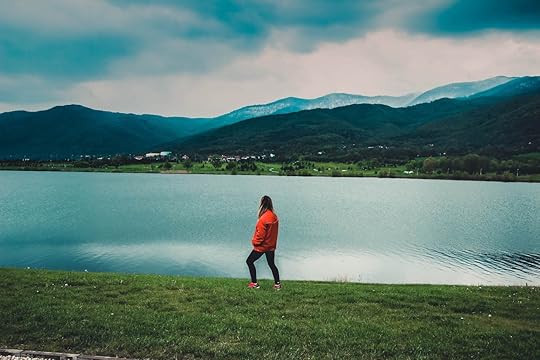
Photo: Dayana Aleksandrova
Regular Instagram users are likely familiar with this feeling of anxiety that comes from scrolling through their feed. Picture after picture of perfectly framed photos that are, at best, telling only part of the story — the part where the poster looks like they’ve got it all figured out. There are the photographers who seem to be in a different country every day, shooting rice terraces and building online courses, right next to those selfless souls you went to high school with, feeding the children of Benin during their Peace Corps service.
I wanted to be that person but had no idea how to make it happen other than to just go. This is exactly what I did, with cliché Liz Gilbert’s Eat, Pray, Love serving as my original source of inspiration. The idea of riding a bike through the lush Balinese jungle and falling in love with a hot Brazilian guy seemed like an appropriate solution to my lack of a plan. So, I bought a one-way ticket to Indonesia with a vision in my head and the naivete of someone too optimistic for her own good.
Once I’d chosen my location, though, it felt as if I had excluded everything else and ended up causing major FOMO. There I was in Bali, practicing yoga and putting down as many glasses of Jamu as I could, but I had difficulty staying in the moment without fixating on what was around the next bend — or off the next tarmac, as it were. The feeling of being dissatisfied and the itch to keep moving snuck right back in.
But I finally learned how to make a decision.

Photo: Dayana Aleksandrova
So I headed off. And then I headed off again and again, finding at least some sort of treasure in each place. I discovered an uncanny ability to negotiate while buying shoes in Morocco and how to stand ground when Thai officials decide to make you jump through hoops for a visa. I still found myself confused a lot though the reason for that confusion began to shift. I went from feeling lost to feeling that I was just out of my comfort zone. A small step, perhaps, but at least there was some direction. Travel can and did bring some meaning to life and as I learned to hold my own and make decisive choices by myself.
It was this budding confidence in my decision-making that allowed me to put down semi-permanent roots in Barcelona. I made the decision to rent an apartment there based on how it would serve me and fit into my life, instead of just how well I could adapt to fit into it for the sake of challenge. Travel helped me age as much as it helped me transition from one stage of life into the next. It taught me that there’s actually nothing wrong with the concept of “home,” especially when it comes to how you feel about yourself. Turns out the temples and monkeys of Ubud were not what I needed to work through my life confusion. Creating a home outside of my home country allowed me to feel like I was still pushing my personal boundaries, without the sense that I was simply fleeing responsibility.
I found out who I am, not who I want to be.

Photo: Dayana Aleksandrova
The bad news is that the question of figuring out what I want and how to get it never really goes away. But the key to relative satisfaction is using travel as a way to work on your self-awareness, rather than as a means to delay entry into the “real world.” Instead of escaping on the nearest red-eye flight every time the going gets tough or the FOMO sets in, journal about your feelings and travel visions. Figure out what who you really are by putting on paper your best qualities, weaknesses, and listing the first 10 things you’d like to accomplish in the near future. Cultivate patience through meditation. Be honest with yourself on your true motivation for escape, and don’t confuse settling into one corner of Earth for failing. Once you feel calm and at peace with yourself and your decision, book a ticket.
Understand that travel can be both a medicine and a poison. It can charge you with positive energy like nothing else in the world, or it can sink you into an even deeper existential crisis than whatever you were feeling post-graduation. Having a really good understanding of who you are, at your core, before you set out on your journey is the best way to avoid that feeling of dread. But if you are just starting out on your path to discovering who you are, that’s ok too; just remember to keep checking in with yourself along the way and know that your needs may evolve. Otherwise, you’ll just keep going, always chasing that next sunset and hoping that the person you want to be awaits on the other side. 

More like this: 7 things you need to know about the woman who travels solo
The post I traveled to fix my quarter-life crisis. This is what happened. appeared first on Matador Network.

Best places to visit in Thailand
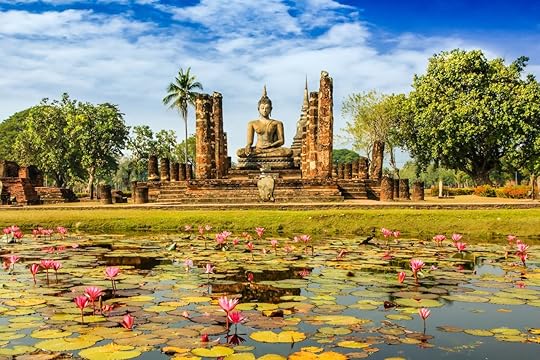
Thailand is among the most talked-about destinations on the planet — though what people have to say varies dramatically. Some travelers come home claiming to have found themselves on long, white-gold beaches. Others turn up their noses at the Thai islands, claiming they’ve been overrun by backpackers. Still others rave about the diving, mountain scenery, and world-class cuisine — it all depends on where you go. Whether your interests align with nature or culture, early mornings or late nights, Thailand has something for every type of traveler. From dazzling coastal resorts to bustling interior cities to quiet spots up north, these are the top places to visit, or discover, in Thailand.
For a splurge you won’t soon forget: Phuket
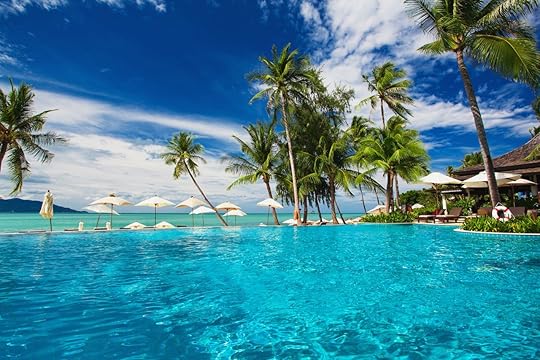
Photo: Martin Valigursky/Shutterstock
It’s easy to be thrifty in Thailand, where penny pinchers can get by on $25 a day, and $100 a day gets you a good deal of luxury. But go for broke on the nation’s largest island and you’ve got a shot at actually, well, going broke. Phuket’s reputed nightlife draws gaggles of go-go bar-goers to the west coast, but away from the intoxicated crowds are some of the first, and best, luxury resorts in the Thai islands. Big spenders and careful savers can rub elbows with celebrity jet setters at Amanpuri, Rosewood, and other luxe properties, running up a tab in spa treatments when they aren’t lounging at bougie beach clubs and dining out at pricey seafood restaurants.
For Thai food fanatics: Bangkok
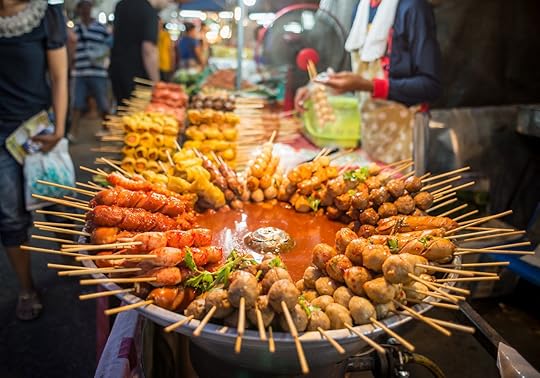
Photo: Room98/Shutterstock
There’s a case to be made that Chiang Mai deserves the Thai foodie crown with its streetside barbecue carts, slurpy noodle soups, and fresh markets open day and night. But nothing beats the variety in Bangkok, from its legendary street food to its buzzed-about haute cuisine, both of which have earned the city Michelin stars.
Thailand’s capital quite literally caters to every type of eater: Big appetite but little budget? Follow your nose down Chinatown’s Yaowarat Road or queue up for one of the crab omelettes that made chef Jay Fai the queen of sidewalk dining. Big appetite and even bigger credit card limit? Treat yourself at Bo.lan or Le Du. Then, when you’re one more bite of coconut curry away from bursting, fill your time with cooking classes or tours of Bangkok’s famous floating markets.
For ethical elephant encounters: Chiang Rai

Photo: C.PIPAT/Shutterstock
Elephants are undeniably adorable. No one would blame you for wanting to get up close and personal with the sweet, sensitive creatures, but more often than not, the elephant experiences in Thailand are exploitative and incredibly harmful. Thankfully, ethical wildlife tourism is a growing trend in Thailand, shifting the focus to rehabilitating the animals rather than entertaining tourists.
Chiang Rai in the nation’s far north has two excellent options for responsible elephant interactions. At the Elephant Valley sanctuary, visitors can observe elephants playing in a natural habitat and even volunteer to help. Another way to go is booking a stay at the Anantara Golden Triangle for ethical encounters with elephants that have been given a second chance, led by mahouts who deeply love and respect their big-eared buddies. Even if you can’t make it there in person, consider sponsoring an elephant as your good deed of the day.
For cheap and chill beaches: Koh Lanta
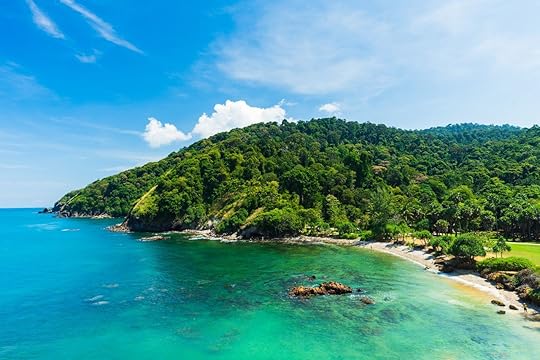
Photo: KorradolYamsatthm/Shutterstock
Koh Lanta is perfect for backpackers that go around apologizing for the backpackers on Khao San Road. Technically a 50-plus-island archipelago, Koh Lanta typically refers to the big island, Koh Lanta Yai. Its miles-long shoreline off the coast of Krabi takes some effort to reach, deterring the hyper-rowdy, Singha-beer-slinging crowd. Stick to the island’s west coast to sleep, eat, and low-key party, but travel south for the most remote beaches. No longer exclusively for beach bums, Koh Lanta has a range of accommodations, but it’s as easy as ever to find a modest guesthouse or decently priced bungalow with all the important amenities but no extra frills.
For jungle treks and safaris: Khao Sok National Park
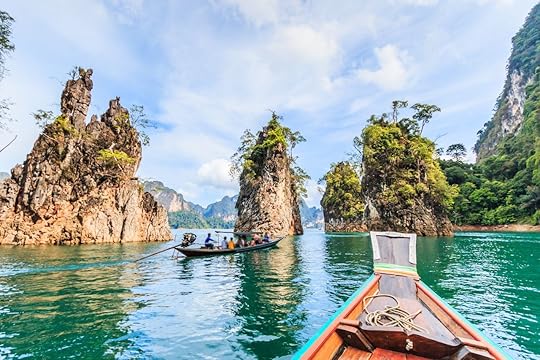
Photo: apiguide/Shutterstock
Khao Sok National Park in southern Thailand hosts one of the world’s oldest rainforests, said to predate even the Amazon. The park’s impressive biodiversity is heavy on hefty land mammals like elephants, boars, bear species, tapirs, monkeys, and marbled cats, whose habitats weave between thick tree canopies and lush jungle, punctuated by karst mountains and the stunning Cheow Lan Lake at the heart of the park. Unplug on a four-day rainforest safari, three-day jungle lake safari, or two-day jungle safari for activities like hiking, canoeing, and bird-watching alongside cultural perks like dance performances and cooking demos in the evening.
For temples galore: Ayutthaya or Sukhothai

Photo: SantiPhotoSS/Shutterstock
The historic centers of Ayutthaya and Sukhothai have both been recognized by UNESCO for being the first and second capitals of former Siam, respectively. Sukhothai dates back to the 13th century when Thai culture was coming into its own and has a temple-filled historical park to prove it. Ayutthaya flourished between the 14th and 18th centuries when it was eventually sacked by the Burmese army. Though the site was never rebuilt, what remains is an impressive display of towering stupas and architectural ruins, evidence of its glorious past.
Neither has much going on for a multi-day stay, so plan on squeezing one or both in as day trips. Ayutthaya is easily accessible from Bangkok, roughly an hour away by car. Less convenient but just as historic, Sukhothai sits between the Thai capital and Chaing Mai, about six hours away from both, making it a good place to stop if you’re moving between the cities.
For rock climbers: Railay Beach, Krabi

Photo: King Ropes Access/Shutterstock
Krabi’s limestone cliffs are more than just a scenic sales pitch. They’re also the talk of the town among climbers in Thailand and across Southeast Asia. Pro cliff scalers beeline for the hundreds of bolted climbing routes around Railay Beach to mingle with the resident monkeys and get aerial views of the reef-studded Andaman Sea. While the routes are advanced, amateurs are in good hands with the many climbing schools set up in the area.
For scuba: Similan Islands
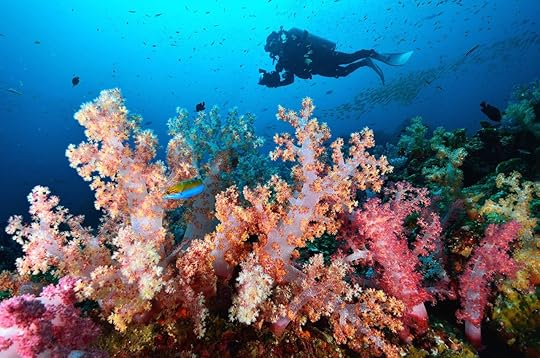
Photo: think4photop/Shutterstock
A cluster of 11 islands in the Andaman Sea, the Similan archipelago is replete with reefs and aquatic wildlife so precious they’ve been protected as a marine park since the 1980s. February through April is the best time for divers, especially those looking to see whale sharks and manta rays, but the dive season extends all the way from late October to early May. PADI Travel recommends booking a liveaboard dive trip, but those looking to take their underwater romps one day at a time will find the easiest and most frequent dive-boat departures from mainland Khao Lak, a string of villages a couple of hours north of Phuket.
For Full Moon Party vibes: Pattaya or Koh Phangan
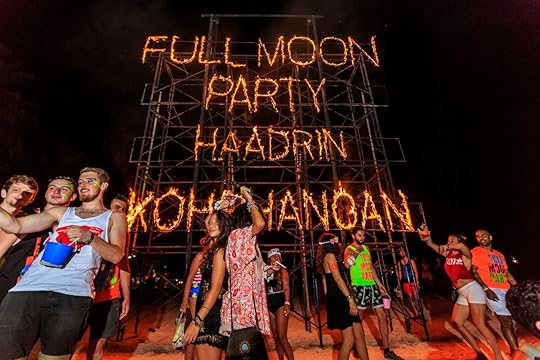
Photo: Golffy/Shutterstock
Thailand wouldn’t be the destination it is today without its reputation for waterside rages, much to the chagrin of many locals and other travelers. If your idea of a Thai vacation starts and ends with buzzwords like “ping pong shows” and “massage parlors,” head for Pattaya southeast of Bangkok. The nightlife is insane, promising neon-lit discos and raucous beer bars, sizzling gay clubs and buzzing cabarets, plus massive backpacker and expat communities that have already scoped out all of the naughtiest spots.
For actual Full Moon Parties — the iconic beach blowouts fueled by fire dancers, druggy debauchery, and ravers dressed in little more than glow-in-the-dark body paint — set your sights on the one and only Koh Phangan. There’s a Full Moon Party every month thanks to the lunar event that it loosely honors, so you don’t need to worry about FOMO here.
For kids: Chiang Mai

Photo: Take Photo/Shutterstock
Thailand isn’t huge to begin with, so when you take away all the places famous for adult activity, the options for parents with young kids narrow like the country’s skinny southern peninsula. Surprisingly, a safe bet for a G-rated vacation is one of the largest, most populous, and most dynamic cities in Thailand: Chiang Mai.
Located in the hills of northern Thailand, Chiang Mai sees a lot of foot traffic, but those driving the tourism tend to prefer family-friendly activities like hiking and temple tours. With a solid tourism infrastructure already in place — suited to travelers from all tax brackets, no less — parents don’t have to deal with hassles of visiting a remote mountain town but can just as easily avoid the admittedly present backpacker scene. Getting around is easy; delicious eats are plentiful; and activities like cooking classes, souvenir shopping, and wildlife encounters are easy to arrange.
For relaxation for days: Hua Hin
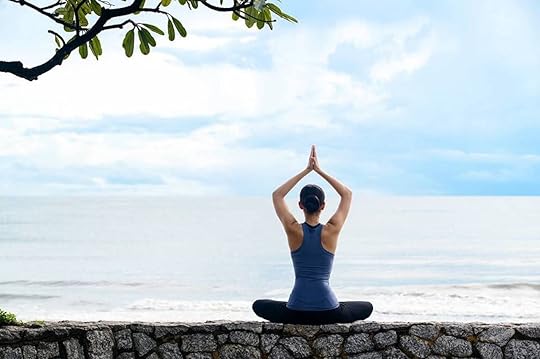
Photo: Chiva-Som International Health Resort/Facebook
At a glance, Hua Hin looks like any other beach resort with a fair bit of development. An early resort for foreigners that’s become more of a weekend hangout for Thai travelers, Hua Hin appeals to anyone interested in good golf or great seafood, but above all else, it’s known as a relaxation center. We can thank Chiva-Som for that.
The wellness resort has long been frequented by stressed-out celebs looking to unwind with its detox programs and rejuvenating retreats, yoga and fitness offerings, and long list of spa treatments, which range from bamboo and herbal massages to acupuncture and skin-smoothing facials. There are several other spas in town as well, so you’re guaranteed to find serenity that suits your budget.
For destination weddings: Koh Samui
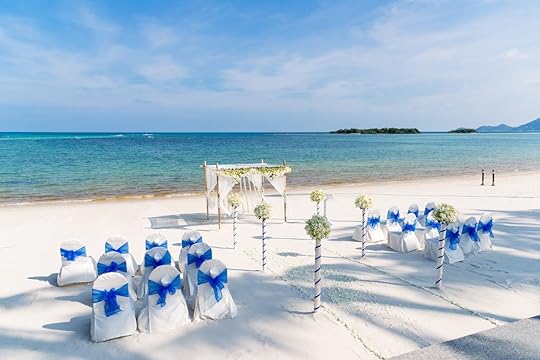
Photo: Eminor b5/Shutterstock
Couples everywhere dream of tying the knot to the thrum of lapping waves, toes buried in fine white sand while the tropical sun beats down. The ideal beach-wedding destination needs a choice of romantic venues and plenty to do outside of the scheduled nuptials without being so popular that beachgoers become unwitting wedding photobombers, all at a flexible price point that justifies flying across the world. Koh Samui delivers on all counts.
Plan on getting hitched between January and March for the best weather, and let the island’s seasoned wedding planners take care of the rest, whether that’s a luxurious Four Seasons reception or low-key beachfront ceremony. In between celebrations, you and your guests can enjoy Koh Samui’s wealth of indulgent dining, relaxing spas, water sports, or maybe even a little nightlife. The best part? You already have your honeymoon destination in the bag. 

More like this: The 7 most amazing temples in Thailand outside of Bangkok
The post The best place to go in Thailand for every type of traveler appeared first on Matador Network.

The best day hikes close to Seattle

Nicknamed the Emerald City for a reason, Seattle is filled with green spaces and no shortage of ways to access them. Whether you want a gentle walk within the city limits or a drive to the nearby Cascades to climb mountains, there is a hike here for every level of outdoors person — many less than an hour away. While most of these treks are relatively family-friendly, remember the forests here are immense. Wear sturdy boots, bring the hiking essentials described below, and let someone know where you’ll be hiking before you hit the trail.
1. Mount Si — eight miles round trip
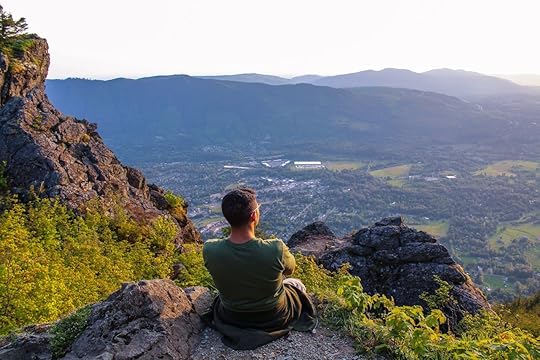
Photo: Laith Higazin/Shutterstock
Mount Si is a great middle-ground hike. It’s straightforward enough that most people can hike to the peak but tough enough that even experienced hikers enjoy reaching the end. Similar to Mailbox Peak below, hikers use Mount Si as a training ground for climbing some of the higher mountains in the area. For this and many of the other hikes on this list, be sure to carry these essentials: water and extra food, compass, sun protection (sunglasses and sunscreen), extra layers, headlamp/flashlight; first-aid supplies, knife, firestarter, and matches.
Starting low, the trail ascends for most of its length going through a variety of areas, ranging from easy to quite strenuous. Passing through a stand of old-growth forest with enormous trees, the climbing becomes increasingly aggressive until you reach the summit. Views of Rainier and the surrounding peaks dominate the skyline. From the top you can see the Haystack. This is Si’s real summit, but it can only be reached by a rough vertical scramble. Be very careful if you decide to climb this. Every year people are badly injured after falling from the Haystack.
Drive time: 40 minutes from downtown Seattle to the trailhead
2. Mailbox Peak — 9.4 miles round trip

Photo: Iveta Hartmanova/Shutterstock
Although wildly popular, this hike is quite the workout. Used by mountaineers as a training ground for climbing nearby Mt. Rainier, this trail is guaranteed to get your thighs in shape for hiking season. After leaving the parking lot, you cross a handful of bridges and creeks before starting to climb in earnest. From here the trail does not let up as you gain switchback after switchback before reaching the mailbox at the top.
There actually is a mailbox at the top of this peak, and hikers decorate it with a variety of stickers and trinkets. The views from the top make the climb worth it as you have a great vantage point of other peaks in the area, as well as Mt. Rainier rising up in front of you. This hike is the toughest on this list, so make sure to bring the 10 hiking essentials and come fully prepared for the task ahead.
Drive time: 45 minutes from downtown Seattle to the trailhead
3. Discovery Park — 2.8 miles round trip
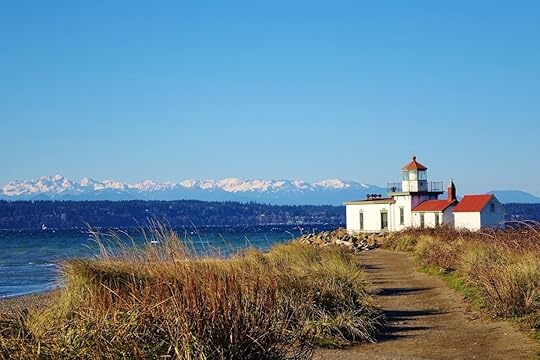
Photo: Dan Lewis/Shutterstock
Not many cities can boast of a 534-acre natural park located within their boundaries, especially one with this much to offer. Discovery Park is perched on a bluff overlooking the Puget Sound, and on a clear day, you can view both the Cascade and Olympic mountain ranges. A variety of trails pass through the interior of the park, allowing guests to see an assortment of environments ranging from meadows to forests to sea cliffs.
In this forested sanctuary within the city, visitors have the chance to spot dozens of bird species they might not normally see. To best experience this park, look at the maps at the park entrance and select a handful of loops to explore. None of the trails are long or strenuous, and all can be hiked relatively quickly.
Drive time: Discovery Park is adjacent to Seattle’s Magnolia neighborhood, and 20 minutes from downtown.
4. Rattlesnake Ridge — four miles round trip

Photo: Podlesnyak Nina/Shutterstock
Rattlesnake Ridge — also called Rattlesnake Ledge — is a classic, though very busy, trail that ends with a beautiful view over Rattlesnake Lake and the Snoqualmie River valley. A straightforward hike, it starts from the parking lot and heads immediately uphill going through switchback after switchback for about two miles until you reach the ledge at the top. The view from the ledge and the cool breeze will make you forget the heart-pounding hike up. The ledge is extremely exposed, ending in a sheer cliff, so approach slowly and carefully. This hike is extremely popular and best done on a weekday or very early on a weekend if you want to avoid the crowds.
Drive time: 30 minutes from downtown Seattle to the trailhead
5. Wallace Falls State Park — 5.6 miles round trip
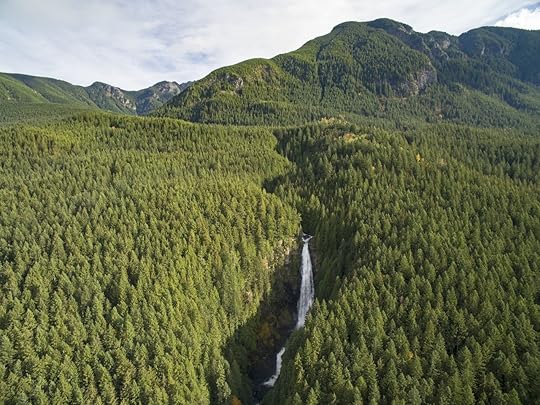
Photo: Cascade Creatives/Shutterstock
Of all the waterfalls included in this list, the three sections of Wallace Falls may be the most impressive. After parking at the Wallace Falls State Park, and starting from below the falls, you’ll walk upriver along a well-maintained trail that follows the Wallace River to the first set of falls — known as the Lower Falls. From here, continue up in elevation to the next (and arguably best) viewpoint for the Middle Falls. Enjoy a panoramic view of this enormous waterfall as it plunges 265 feet into a splash pool before continuing on through a series of smaller tiers. There is one more viewpoint further upriver after a thigh-burning half-mile of switchbacks that gives you a view of the top of the falls.
Drive time: One hour from downtown Seattle to the parking lot
6. Twin Falls — 2.6 miles round trip

Photo: Sean Pavone/Shutterstock
Located within Olallie State Park, the Twin Falls trail is a moderate out-and-back hike that leads to a set of waterfalls tucked into a small canyon. The trail starts by following along the river before heading into a swampy section of forest, where you can see skunk cabbage in the spring and wildflowers in the summer. Occasionally elk can be seen or heard nearby.
After climbing a series of gentle switchbacks, hikers arrive at a bench that gives a view of the falls across the river valley. Continuing along the trail for another couple of minutes, you will reach a set of steep stairs that deliver you to the viewpoint of the lower falls. This is a veil-style cascade that gently flows down an enormous slab of rock. Walk back up the stairs and continue onto the bridge, which crosses the river above the lower falls. From here you can view the upper falls, which is a series of two “twin” falls.
Drive time: 40 minutes from downtown Seattle to the trailhead
7. Franklin Falls — two miles round trip
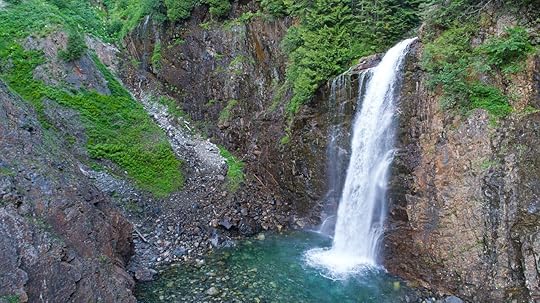
Photo: Cascade Creatives/Shutterstock
Franklin Falls is one of the best “bang for your buck” hikes in the area and a great place to bring new hikers or visiting family members who want to see some of the splendor of the Pacific Northwest. The hike is a gentle mile out along a well-marked and sturdy trail to an impressive 70-foot waterfall that crashes into a large splash pool below. When the falls are running at their peak, consider bringing a rain jacket to protect yourself from the spray given off. During winter months, this makes an excellent beginner snowshoe trek to see a frozen, icicle-covered waterfall. This is one of the most popular hikes in the area, so arrive early to get a parking spot.
Drive time: 55 minutes from downtown Seattle to the trailhead
8. Pratt River Trail — six miles round trip
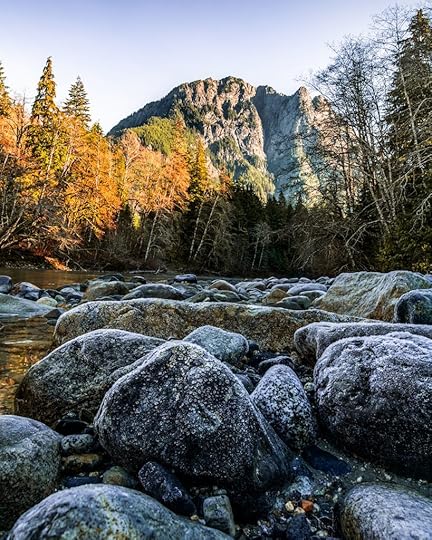
Photo: Jesse Snyder
The Pratt River Trail is an excellent choice for hikers of all ages and abilities. Starting from the parking lot, you cross the middle fork of the Snoqualmie River on a rustic wood and metal bridge then continue downstream. During spring and summer, the trail plays host to a variety of blooming wildflowers, riverside fauna, and excellent birding opportunities. This makes a great winter hike because of its low elevation, which gives you a chance to get out when the high country is snowed in. The hike is an out and back, but by taking advantage of a variety of connecting trails, it can be extended nearly indefinitely.
Drive time: One hour from downtown Seattle to the trailhead
9. Coal Creek Falls — 2.5 miles round trip
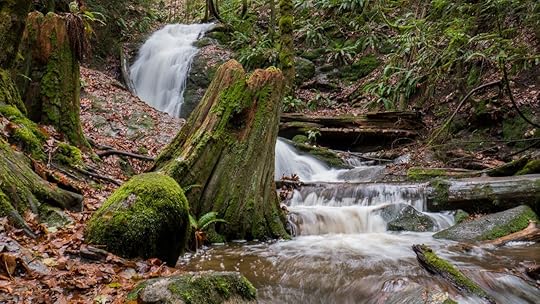
Photo: Jesse Snyder
Nearby Coal Creek Falls is a perfect choice for a family-friendly hike that works in any weather conditions. A well-maintained trail leads through a thick forest filled with a variety of deciduous and evergreen trees, berry patches, and wildflowers. Coal Creek Falls sits within the Cougar Mountain Regional Wildlife Park, which was a coal mining site from 1863 until 1963. Alongside the trail are reminders of this past; visitors can see large holes that are evidence of old mine cave-ins. Stay on the trail and follow the park’s signage to avoid injury. After hiking roughly 1.25 miles, you’ll come across Coal Creek Falls. It’s a pretty — but small by Pacific Northwest standards — waterfall that can be easily viewed from a bridge running across the creek below the falls.
Drive time: 25 minutes from downtown Seattle to the trailhead 

More like this: 5 extraordinary hiking trails you won’t believe are in the United States
The post The 9 best hikes within one hour of Seattle appeared first on Matador Network.

How to survive in the woods
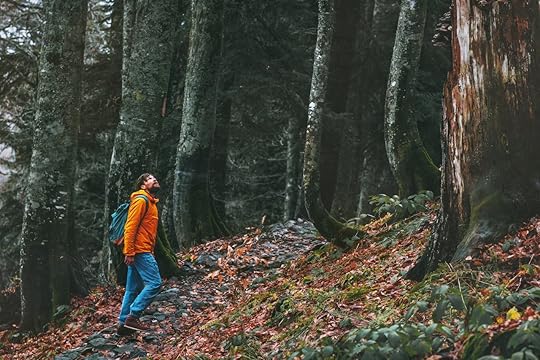
Getting lost in the woods is up there with tarmac delays on the list of travel nightmares. Except there’s no free sodas and Biscoff cookies if you’re there longer than three hours. You’ll need to find your own food and water, a place to sleep and stay warm, and, eventually, your way out. Though we’ve never had the pleasure of being lost in the woods, hundreds of people have. And the folks at SmokyMountains.com culled through their stories to find out what those people did to survive.
Note that we don’t actually endorse a few of these… ahem, creative methods, but they did get the job done in keeping the stranded person alive. Thankfully, the website also sought the advice of Wildlife Ranger and survival instructor Andrew Herrington, who adds his more practical tips to those of the survivors.
Staying warm
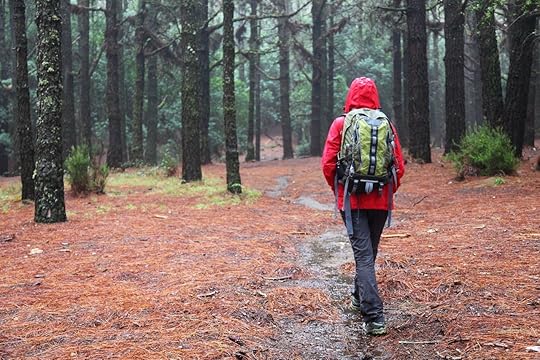
Photo: Maridav/Shutterstock
Pressing your body up against another human is a commonly cited method of staying warm. Some choose the classic spooning method while others, like 19-year-old Tommie Henricks and his companions, opt to do stuff like stick their toes in each other’s armpits — which they did when they were lost for two days in Cross Couloir, Colorado.
If you’ve got canine companions, they’ll keep you warm too, as they did for Annette Poitras when she got lost on Eagle Mountain in British Columbia. Chloe, her pet collie, and Bubba, her pug mix, took turns laying on top of Poitras to keep her warm.
Lacking a pet or another person, you can also do calisthenics in your sleeping bag, like Jorge Joachim did while he was lost for nine days in Jasper National Park, Alberta. Or find moss to pile on top of yourself as an unnamed lost hiker did in Bear Lake, Oregon.
Finding shelter
Alan Austin got caught in a freak snowstorm while skiing in Squaw Valley, California, and dug a six-foot snow cave, lined with branches and pine needles for insulation. Mary Owen did the same thing to help survive almost a week in Mt. Hood, Oregon.
Of course, plenty of people get lost when it’s not snowing, and if you can find a hollowed-out tree trunk, it makes excellent shelter as it did for Lacy Murphy when she survived two days on Mt. Rainier.
Herrington suggests bringing a 55-gallon trash bag along to create a water-resistant shelter. He also suggests using a tarp, puffy jacket, or quilt.
Drinking water
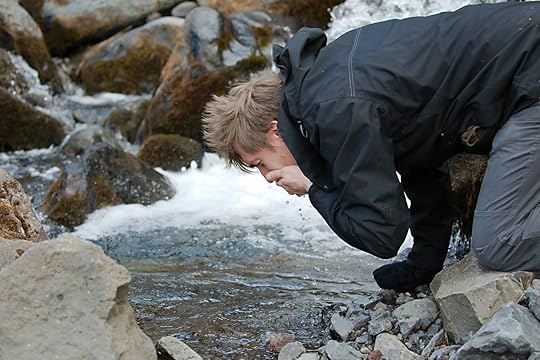
Photo: Peter Gudella/Shutterstock
On average, you can survive about three days without water, but if you’re trying to find your way out of the wilderness, odds are you’ll need more.
Many of the survivors in the study found lakes, streams, and other bodies of water to drink from. Even if you think the water might be contaminated, which it very well might be, Harrington says your odds are you’ll be rescued within 24 hours, so you should be more concerned with dehydration than infection.
That was Gilbert Dewey Gaedke’s logic when he spent five days wandering a lava field on the Kilauea Volcano in Hawaii. With no natural water sources, he began squeezing water from moss to survive.
Aron Ralston, famous for amputating his own arm to free himself from a boulder, drank his own urine to stay hydrated during his ordeal. As did Ronald Hutter, who kept his arms and survived four days drinking urine in Mt. Lemmon, Arizona. Ed Rosenthal did the same when he was lost in Joshua Tree, as well as foraging water from cacti.
In the right environment, though, drinking urine won’t always be necessary. Nineteen-year-old Lukas Cavar was lost in Sullivan Cave, Indiana, and trapped moisture from the cave in empty candy bar wrappers. He also licked the cave walls to stay hydrated, and Lacy Murphy licked leaves and moss to stay hydrated on Mt. Rainier.
Getting food
Most people have about 30 days worth of calories to live on, so no need to panic like Eric LeMarque, who ate some of his own flesh while stuck in Mammoth Mountain for a week.
That said, starvation is never fun, so Harrington suggests packing lots of small, high-calorie foods like almond butter and coconut oil packs. He also says trying to hunt or forage for food is going to cost you more calories than it’ll gain, so your best bet is to make do with what’s around you.
If you’re planning a venture out into nature, do a little prep work and find a Mexican restaurant that serves chapulines. Snacking on grasshoppers will get you over the “Ew, I’m eating bugs” mental block, so if worst comes to worst, you’re cool snacking on insects — one of the best protein sources in nature. We’re not sure Greg Hein did this before he got lost for a week in Kings Canyon National Park. But he still survived off crickets, large ants, and water bugs before he was noticed by a rescue helicopter.
Even if you’re hungry, rationing your food is essential. This was how David Vetterlein survived 16 days in Siskiyou National Forest on 12 cornmeal muffins and salmon jerky. Rick Moyan rationed himself two oranges, three cookies, nine Tic Tacs, and two Werther’s Originals a day for six days to stay nourished in Keremeos, British Columbia.
Those who survived more than 30 days did, however, have to resort to extremes. Marco Lavoie was stuck for a whopping three months on Mattagami Lake in Quebec. He even survived a bear attack, thanks in large part to his trusty dog. For his service, the dog was unfortunately turned into lunch, as Lavoie ate his best friend on day three, for some reason, before he tried fishing.
Getting back to safety

Photo: Petar Paunchev/Shutterstock
Nearly two-thirds of those who were rescued kept moving when they realized they were lost. However, Herrington says if you tell people where you’re going your best bet is to stay put as they will be looking for you on your route. Since three-quarters of those lost were found by rescuers (versus finding their own way out) you’ll have better odds if you make it easier for them to find you.
He suggests packing bright tarps and clothes, and bringing signaling mirrors so you can flash light at potential rescuers. That was ultimately how Gaedke escaped his Hawaiian lava field and how Lon McAdam ended his week lost in Superstition Wilderness, Arizona.
If you didn’t tell anyone where you were going, (which, by the way, don’t do that), following water is usually a good path to safety. Eighteen-year-old Austin Bonahan discovered this when he lost his stepfather on a hike through Great Smoky Mountains National Park. He followed a stream down a mountain to a large creek, where he found a man and his daughter boating. You might also try following animal tracks, as Marcus Mazzaferri did in Yosemite National Park following deer tracks to escape.
How to prepare for the worst-case scenario

Photo: Tyler Olson/Shutterstock
Before leaving, Herrington says you absolutely must leave your trip plan and check-in time with two different people. That way if you don’t arrive where you’re supposed to be on time, people can start looking.
You also should study your maps and find escape routes if you get lost, and print the maps instead of relying on GPS or other battery-powered technology. In addition to carrying essentials like flashlights, compasses, and first-aid kits, bring water purification tablets and fire-making gear like Vaseline-soaked cotton balls and matches/lighters.
Layer your clothes with a bright, outer Gore-tex shell, using stuff like Merino wool so it breathes and dries easily.
If you do find yourself lost, bring a knife so you can mark your trail by snapping branches and skinning trees, then follow the white marks in the bark to retrace your steps. Also, look for geographic features on the ground, and compare them to your maps so you can get a general sense of where you are. 

More like this: How to prepare for a high-altitude trek
The post How to survive if you get lost in the woods, according to people who’ve done it appeared first on Matador Network.

Best cities in the US for a cannabis
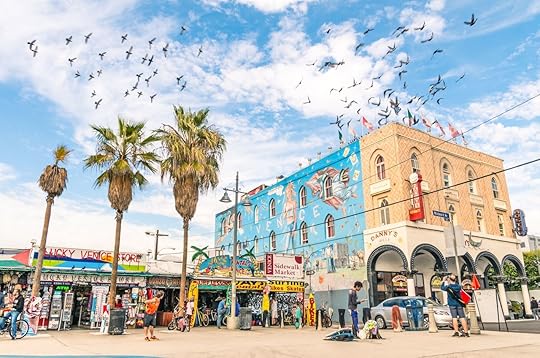
The number of states that allow recreational cannabis is rapidly growing. It’s inspiring a new class of travelers — the cannabis class — to get out of their homes to visit places where weed is warmly embraced. Even for the least experienced, the legal experience is a curiosity for people passing through on pleasure or business.
Yet not all cities are created equal. Some cities in recreational states don’t allow sales while others lack the infrastructure to have a solid selection of shops or activities. The best cities, however, are an experience. Book your flight, learn about what to expect on your first dispensary visit, and get going to the best cities in the US for a cannabis vacation.
1. San Francisco

Photo: kropic1/Shutterstock
Few places are as important to pro-cannabis activism as San Francisco and nearby Oakland and Berkeley. It’s never been difficult to find weed in the city, but recreational dispensaries have made it easier than ever. Come for the hippie culture history, stay for the selection of pot-friendly activities.
What to do: If you haven’t gone before, stroll Haight Street for a look at the epicenter of legalization movements in California. It’s become much more touristy but is still worth a peek. Stroll by the ocean at Golden Gate Park, and spend as many hours as you can dining on the city’s world-class food.
Where to stay: Hotel Kabuki is one of a small number of hotels in the city that allows consumption.
Rules to know: You’d never guess it, but you’re not allowed to smoke in public in San Francisco. There are a fair number of lounges, though.
2. Los Angeles

Photo: robert cicchetti/Shutterstock
Southern California has embraced cannabis culture for decades, but it only opened up recreational sales relatively recently. Now, with options steadily and constantly improving, Los Angeles has become a top marijuana destination. It’s home to The Standard, Hollywood, which was the first hotel with a cannabis dispensary, and LA has so many wellness retreats you can live your life going from wellness retreat to wellness retreat and never see the outside world again.
That’s all on top of the fact that California weed has earned a solid reputation. If you’re in Central or Southern California, look for cannabis grown in nearby Santa Barbara County, Autumn Shelton, the co-founder of Autumn Brands, says. “This area has the perfect climate for growing world-class cannabis,” Shelton says, “and has quickly become the ‘wine country’ of cannabis on the Central Coast.”
What to do: Spend some time in Venice Beach, which has long been a center for marijuana culture. There are a number of clubs and lounges, like Alchemy Lounge, where you can grab a day pass and waste away the hours, although getting out in that California sunshine is hard to beat. Also, LA is a food lover’s paradise with some of the best street food, markets, and upscale dining in the state.
Where to stay: The Standard, Hollywood and Moment Hotel
Rules to know: While there’s a pretty lax level of enforcement, public consumption is technically illegal in LA.
3. Las Vegas

Photo: littlenySTOCK/Shutterstock
With recreational cannabis sales starting in the summer of 2017, Nevada is one of the newer states to embrace legal consumption. It’s gone full Vegas and fast. As of 2018, cannabis sales sent more tax dollars to the state than alcohol sales, according to the Las Vegas Review-Journal. Las Vegas is home to the largest dispensary in the country, Planet 13, which is truly like a 40,000-square-feet theme park unto itself with an LED light and water show. And that’s just the start.
“Las Vegas has taken a progressive approach, allowing cannabis to become quickly integrated into the community despite social consumption lounges or public consumption not being legal yet,” Kevin Love, vice president of market activations for Two Roots, says. Case in point: The city is home to the Las Vegas Lights, which is the world’s first professional soccer team sponsored by a cannabis brand, Two Roots.
What to do: Check out the best dispensaries in Las Vegas. Once you’re stocked up, visit Dana’s Place in Las Vegas Releaf, which is the world’s first cannabis dispensary speakeasy, and the cannabis museum Cannabition. Even if gaudy lights aren’t your thing, make a point to stop at Planet 13.
Where to stay: Since many of the iconic Vegas hotels are attached to casinos, and casinos can’t allow cannabis, you’ll have to venture off the Strip to find a weed-friendly place to stay. One solid option is The Artisan. Another more residential option is to book with Clairbnb, which has highly Instagrammable and cannabis-friendly options.
Rules to know: It’s illegal to consume cannabis on public and casino property, and the rule is strictly enforced when it comes to the latter. The city’s airports are strict about even possessing cannabis products, so make use of the safe disposal boxes located around the entrances to the Vegas airports.
4. Denver

Photo: welcomia/Shutterstock
There are more than 150 recreational dispensaries in Denver, making selection alone a reason for the city to be on your list.
“Colorado and Denver have a lure for every type of traveler: the foodie, art or music lovers, and the outdoor enthusiasts,” says Amy Andrle, co-founder of L’Eagle, one of Denver’s original dispensaries. “Couple those activities with cannabis and you have a fantastic pairing for both the first timer and/or the legacy user.”
What to do: First, make a stop at Denver’s best recreational dispensaries. Then there’s Red Rocks, a concert venue that’s just as fun for hiking and the museum even when there’s no music. The RiNo neighborhood’s colorful murals are a feast for the eyes, and the quickly rising Denver restaurant scene can keep even the pickiest eater satisfied. Then there are all the museums, like the Museum of Outdoor Arts, Meow Wolf, Denver Art Museum, and Museum of Contemporary Art. If you really want to go all out, there are a number of slightly ridiculous 4/20 tours, such as sushi and joint rolling.
Where to stay: While most hotels prohibit consumption, there are plenty of cannabis-friendly choices. Some of the upscale notable options include Bud + Breakfast and Summit Recreational Retreat.
Rules to know: Public consumption is illegal in Denver, despite how many whiffs of weed you catch on the streets. There are a few social smoking clubs and lounges, but they’re geared more toward serving locals and require a membership. Also, thanks to the sheer number of options, first-timers should “do their homework when selecting a dispensary, and make sure it is a reputable establishment with a track record for taking time with new clients and investing the energy in educating the visitor to all varieties and methods of consumption,” Andrle says. Treat it like any other destination trip. “A wine enthusiast in Napa is not going to seek out the cheapest most common bottle,” Andrle says. “They seek an experience.”
5. Seattle

Photo: Sean Pavone/Shutterstock
The Pacific Northwest is known for its rainy days and expansive forests, but it’s also a destination point for people looking to consume cannabis on their vacation. Washington was on the forefront of legalizing recreational cannabis (the first, along with Colorado), and the industry in Seattle is developed and has had some time to get any kinks worked out. It doesn’t hurt that the city is so close to so many types of nature and has an incredible food scene.
What to do: After a stop at Seattle’s best cannabis dispensaries, go see the view from the Space Needle. Pike Place is a must-go for anyone who likes to eat (so, everyone). Make your trip a long weekend and take some time to explore the outdoors at Olympic National Park. If you happen to be in Seattle on 4/20, go to Hempfest, one of the largest and most enticing celebrations of all things cannabis in the country.
Where to stay: The Winston House and The Bacon Mansion
Rules to know: Public consumption is illegal. 

More like this: The best recreational cannabis dispensaries in America
The post The 5 best cities in the US for a cannabis-inspired vacation appeared first on Matador Network.

What do in spring in New York City
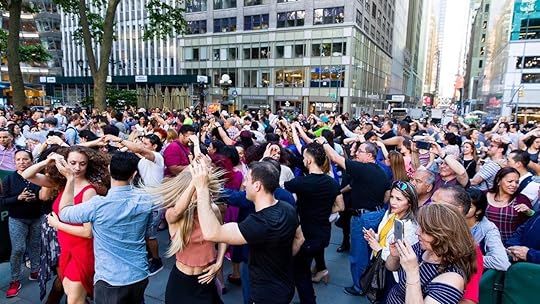
Temperatures are finally rising after the long winter months, which means most people in New York City are eager to be out and about and enjoying the sun without having to worry about getting sick or bundling up. One of the best things about spring here is the abundance of events and festivals, which means there’s always something going on whether it’s a Monday afternoon, Wednesday evening, or weekend. From eating to your wallet’s content at a food festival to free theater in Central Park, here are eight events you can attend to celebrate spring in NYC.
1. Cherry blossom festivals

Photo: Linda Harms/Shutterstock
Cherry blossom season in Japan is not to be missed, but if you can’t make it, there are plenty of other places you can see the beautiful flower bloom. In the US, Washington, DC, and NYC have some of the best, and most fun, cherry blossom festivals come springtime. These celebrations began as a direct result of Japanese Mayor Yukio Ozaki gifting cherry blossom trees to the US to symbolize the bond between the two nations. In NYC, you have two options to see the white-and-pink flowers: the Brooklyn Botanic Garden and Randall’s Island. In additional to the traditional hanami (flower viewing), the festivals will have musical and dance performances, art demonstrations, short classes on things like taiko drumming, shops, food, and more. Be sure to check the websites for more information on ticketing.
2. Food festivals and markets
Food and drink are an integral part of New York culture, from the best burgers and sweetest desserts to wine bars and breweries. As such, it stands to reason that we do everything we can to celebrate that culture. A vast number of food and drink festivals pop up once temperatures rise, such as the BBQ Cookoff, Food Truck Fest, Maple Fest, Hot Sauce Expo, Ninth Ave International Food Festival, and New York Beer Fest. Some food markets, like Smorgasburg and the Queen’s Night Market, occur on a weekly basis.
3. Tribeca Film Festival

Photo: Ovidiu Hrubaru/Shutterstock
Beginning in 2001, the Tribeca Film Festival was founded by producer Jane Rosenthal, actor Robert DeNiro, and philanthropist Craig Hatkoff in response to the demoralized community following the 9/11 attacks. The festival is where both emerging and established filmmakers can debut their works to a larger and broader audience. While independent films are the primary focus at TFF, some studio films like Star Wars: Attack of the Clones and The Avengers have premiered there and continue to do so.
In addition to films, events for TV, games, and virtual reality also occur. Programming hours vary depending on the day and take place at different venues around the neighborhood. Ticketing also depends on the type of programming you attend, and obtaining a spot can be as easy as purchasing it on the website or having to wait on a standby line. The festival runs from April 24 to May 5.
4. The Orchid Show
The New York Botanical Garden in the Bronx may not have a cherry blossom festival, but it’s definitely worth a visit in the spring nonetheless. It puts on a wide array of exhibits throughout the year, but late winter through the end of April is the annual flower festival. This year’s theme is “The Orchid Show: Singapore” as a tribute to Singapore’s national flower. It features thousands of orchids in a variety of colors and shapes, with some towering well above human heights and others in overhead arches.
Prices are cheaper if you visit on a weekday, with it being $23 for adults, $20 for seniors and students with a valid ID, $10 for children ages 2-12, and free for children under two; on a weekend, it’ll be $28, $25, and $12. If you’re 21 and over, you can attend the orchid evenings for $38, where everything is lit up in true Singapore fashion. There’ll be a DJ, as well as food and drinks for purchase.
5. Dance Party in Bryant Park

Photo: Bryant Park
Located in Midtown, Bryant Park is known for putting on fun programming, from bumper cars to ice skating to silent discos. One popular event is the weekly dance parties, where a type of dance will be taught to attendees every Wednesday — one day you might be learning to salsa and another you might be partnering up for some ballroom. There’ll be an hour of instruction from 6:00 PM to 7:00 PM, and then there’ll be live music from 7:00 PM to 8:30 PM to put your new skills to the test.
6. Earth Day
This year, Earth Day is on April 21. While NYC may not be the cleanest or greenest city, we try our best to help environmental efforts in the ways we can. You’ll be able to find a number of celebrations paying tribute to Earth Day all throughout the five boroughs, from car-free streets to beach cleanups to 5K walks.
7. Shakespeare in the Park

Photo: The Public Theater/Facebook
Broadway theater can err on the pricey side if you don’t want to queue up for hours in the early morning or try your luck with a lottery, but Shakespeare in the Park provides a free alternative, with the added bonus of being outdoors. The mission of the company behind it, The Public Theater, is to make theater accessible and relevant for everyone. It kicks off in the spring on May 21 with Shakespeare’s Much Ado About Nothing, which will be put on until June 23. When summer begins, the production will switch over to Coriolanus. It’s held in the open-air Delacorte Theater in Central Park. Tickets are given out on the day of each performance at various locations in the five boroughs, but you can also try the in-person lottery at The Public Theater or the digital one on Today Tix.
8. Governors Ball
Held on Randall’s Island, Gov Ball is one of the premier music festivals on the East Coast. A wide range of genres can be found here, including pop, indie, rock, hip hop, and EDM. It attracts artists of all kinds, from big names to rising stars, and there are several music stages. This year’s line up includes Florence and the Machine, The Strokes, and Tyler, the Creator. The festivals span three days, from Friday, May 31, to Saturday, June 2. There are four kinds of tickets, and each comes with its own set of benefits: general admission, VIP, VIP plus, and platinum. All ticket levels offer a layaway plan and, barring platinum, can be purchased for a single day or the entire three days. 

More like this: 5 NYC parks you should visit that aren’t Central Park
The post 8 events you can attend to celebrate spring in New York City appeared first on Matador Network.

UPS driver takes pictures with dogs

We tend to think that mail people and delivery drivers have a hard time dealing with dogs on the job, but it seems that we got it quite wrong. This UPS driver in Louisiana is proof that their daily routine is not filled with barks and barred teeth. To make sure we get the message, Jay takes pictures with the dogs on his route and posts them on Instagram with his own hashtag: #pupsofjay.
Jami Attenberg, one of the customers along Jay’s route, alerted the Twittersphere to her UPS guy’s affinity for dogs with a tweet. “I have extremely important news and it is this,” she said. “My sweet UPS guy has a hashtag of all the dogs in the neighborhood.” And in case anyone thought Jay was shirking his delivery duties to take pictures with adorable dogs all day, Attenberg also added, “He is very good at his job! Top notch guy!”
Another customer, Sarah, replied to Attenberg saying, “Omg Jami that is my sweet UPS Jay and this is a picture of him and my dog, Sophia.”
I have extremely important news and it is this: my sweet UPS guy has a hashtag of all the dogs in the neighborhood. https://t.co/AVk5abA67G …
— jami attenberg (@jamiattenberg) 27 mars 2019
Indeed, a quick scroll through the #pupsofjay feed shows that Jay has probably taken photos with many dogs along his route. Some of them have even generated over 1,000 likes. 
View this post on Instagram
A post shared by Jason Hardesty (@jhardesty) on Feb 8, 2019 at 3:59pm PST
View this post on Instagram
A post shared by NOLA.com | The Times-Picayune (@nolanews) on Mar 28, 2019 at 7:45am PDT
View this post on Instagram
A post shared by Jason Hardesty (@jhardesty) on Mar 22, 2019 at 4:23pm PDT

More like this: Everything you need to know about taking your dog into the great outdoors
The post This UPS driver takes Instagram photos with the dogs on his route and we can’t even appeared first on Matador Network.

Matador Network's Blog
- Matador Network's profile
- 6 followers



